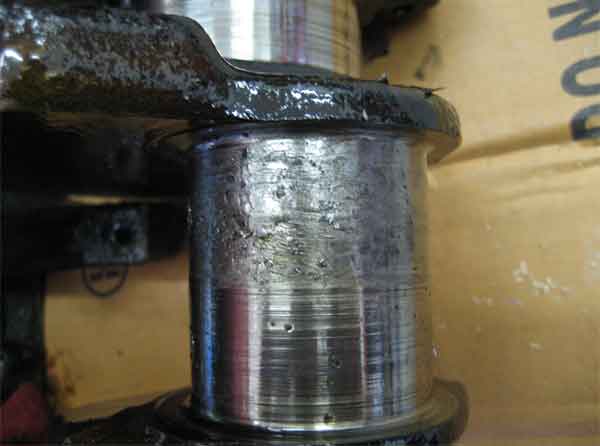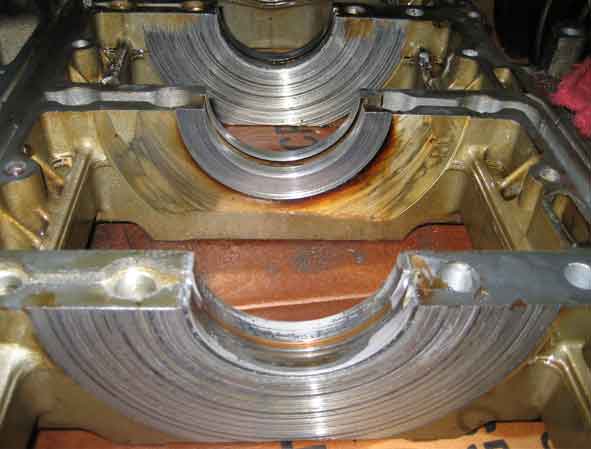

Sharks Bitten by Thrust Bearing Engine Failure
Perfectly good engines totally ruined by a failure on the main crankshaft. Suspected cause is the crank getting "axially loaded" or pushed against the thrust bearing located at the center of the crank. The crank then machines the bearing sides resulting in a seized crank and major engine failure. Cost to repair - $4500 for a used engine,( you may get one for less if you are lucky), but with labor the total will easily exceed $5500. This kind of repair on low mileage cars too! Even though it's rare, this problem is NO JOKE!
Of course it begs the question - How does this happen? We have a theory, just a theory at this point to offer an explanation. The problem occurs in Automatic transmission cars, and we suspect only in S4's or better, for the reasons below.

Caution - It's Just a Theory....
For automatic cars the crankshaft is fixed to a flywheel/drive plate, which is clamped to a central shaft internal to the torque tube. The outer part of the tube is bolted to the drive plate housing. At the other end the central shaft is connected to the transmission by a coupling and the outer tube bolted to the transmission case.
This assembly fixes the length between the engine and the transmission. When the central shaft is installed the drive plate is first bolted to the flywheel with the coupling or clamping sleeve loose. This allows axial movement. The clamping bolt is then tightened.
For axial loading to occur the central shaft must somehow "grow" by a mm or more in length, whilst being connected at each end. This could actually happen as the central shaft is severely flexed, or twisted. Each time the shaft twists, the metal does not return to its original state and "necks" or deforms causing an increase in length. This might happen for defective or abused shafts, ones that have suffered repeated driveline shocks. Perhaps only for S4 cars or better as they are capable of increased torque. We doubt this would happen on earlier models.
The factory manuals states for cars 85 and up, no drive plate adjustment is required. Presumably this is because of the design change in the thrust bearing surfaces. Thus the remedy would be to simply undo one or both of the coupling bolts to relieve any loads present due to an elongated torque tube. You also might consider rotating the engine once or twice by hand with the bolts loose, before re-tightening to specified torque.
If it is known that the driveline has experienced severe shocks, the central shaft should be at least checked for length against a new one, or replaced. Also if a car has suffered a bearing failure then consider checking or replacing the central shaft. For all others be wary not to repeatedly shock your driveline, e.g.. as might occur with a slipping transmission that "catches" hard on a downshift, enough to let out a chirp of the tires.
Repair Information from Porsche's Tech Service Bulletin:
"After the central tube is bolted to the forward housing, first tighten the six (6) drive plate attaching bolts (A in Figure 1) to 32-39 N-m (23-28 ft.lbs.). Then tighten the clamping screw (B in Figure 1) to 75-85 N-m (54-62 ft.lbs.). Following this procedure will ensure necessary running clearance for the crankshaft thrust bearings. Any damage to the engine which has been caused by improper central tube installation is NOT a warranty matter. "
<Yeah, but did they know that their driveshafts were sprouting leaves>
New bearing crankshaft axial play is .110 - .312 mm the wear limit is .40 mm
(note this is metric mm )
==========
A crude crank end play test is easily done with a flashlight and a large
screwdriver. It is just axial shuck of the rotating assembly. It should be near
undetectable for the mere human. If it's a millimeter it is baaaaaaaaaad. That
can be felt by even gently prying behind and in front of the large crank pulley
cluster even with the belts on in a motor that has run and is oiled.
Thrust bearing failure should make millimeters not thousandths of an inch of end
play. I have seen motors with 1/8" still running and not leaking any fluids and
not really making any noise (not just talking about 928 motors here. Heck, I saw
an old beetle motor with the case halves so loose you could see them separate on
idle strokes and it was still running :)
jfk
79 (crank endplay OK but I wouldn't call it tight :)
==========
What a broken bearing looks like?




=======
20 years ago the Porsche agents over here could not get my flexplate clamp to
hold. They told me there was nothing wrong with the design but upon contacting
Germany, within 10 minutes Porsche Engineering recommended use of new bolts and
to over torque by 10% and it worked- for two weeks- then it slipped! If there
was "no known problem" how come they were able to respond like that in 10
minutes! At that time there were no secondary solutions on the market and I
refused to accept the Porsche "solution". We then came up with the Loctite
solution and that saved my motor and still does to this day.
The bullet proof solution is to use Constantine's clamp or if you want ease of
installation the Ritech clamp that Roger markets is also an interesting
approach- not sure if Ken still does his PKlamp. If and when I ever have to redo
the clamp after major intervention I would use Constantine's clamp assuming it
was still on the market but at least I know I can fallback on the Loctite with
confidence if I had to.
Whatever approach one chooses to use, it amazes me that we still to this day
read of this problem happening - sometimes [sadly] with dire consequences.
Anyone who relies on the integrity of the stock installation is really playing
"Russian Roulette" with their motor. Some hold some do not- we have never been
able to figure that one out- I put it down to production tolerances and driver
enthusiasm but whatever the cause the damage is a given when it happens.
Given you know yours is "slipping" the obvious question has to be "how many
shots do you have left before you hit the chamber with the round in it?"
__________________
Fred R